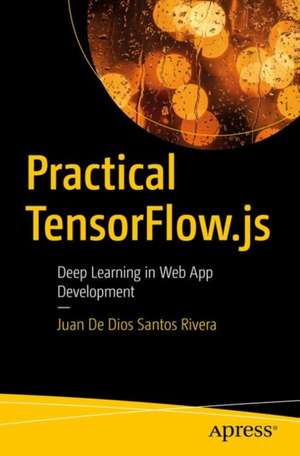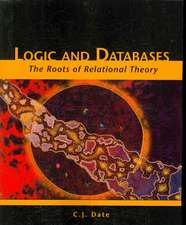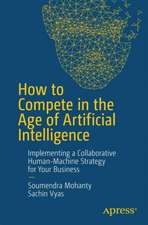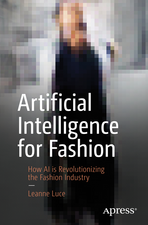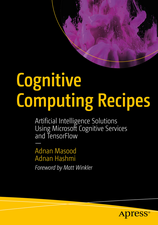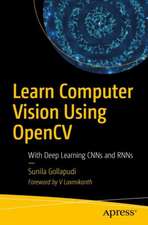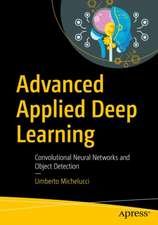Practical TensorFlow.js: Deep Learning in Web App Development
Autor Juan De Dios Santos Riveraen Limba Engleză Paperback – 19 sep 2020
The most common and accessible platform users interact with everyday is their web browser, making it an ideal environment to deploy AI systems. TensorFlow.js is a well-known and battle-tested library for creating browser solutions. Working in JavaScript, the so-called language of the web, directly on a browser, you can develop and serve deep learning applications.You'll work with deep learning algorithms such as feedforward neural networks, convolutional neural networks (CNN), recurrent neural networks (RNN), and generative adversarial network (GAN). Through hands-on examples, apply these networks in use cases related to image classification, natural language processing, object detection, dimensionality reduction, image translation, transfer learning, and time series analysis.
Also, these topics are very varied in terms of the kind of data they use, their output, and the training phase. Not everything in machine learning is deep networks, there is also what some call shallow or traditional machine learning. While TensorFlow.js is not the most common place to implement these, you'll be introduce them and review the basics of machine learning through TensorFlow.js.
What You'll Learn
- Build deep learning products suitable for web browsers
- Work with deep learning algorithms such as feedforward neural networks, convolutional neural networks (CNN), recurrent neural networks (RNN), and generative adversarial network (GAN)
- Develop apps using image classification, natural language processing, object detection, dimensionality reduction, image translation, transfer learning, and time series analysis
Who This Book Is For
Preț: 325.98 lei
Preț vechi: 407.48 lei
-20% Nou
Puncte Express: 489
Preț estimativ în valută:
62.37€ • 65.13$ • 51.51£
62.37€ • 65.13$ • 51.51£
Carte disponibilă
Livrare economică 25 martie-08 aprilie
Preluare comenzi: 021 569.72.76
Specificații
ISBN-13: 9781484262726
ISBN-10: 1484262727
Pagini: 303
Ilustrații: XXIV, 303 p. 67 illus.
Dimensiuni: 155 x 235 x 24 mm
Greutate: 0.5 kg
Ediția:1st ed.
Editura: Apress
Colecția Apress
Locul publicării:Berkeley, CA, United States
ISBN-10: 1484262727
Pagini: 303
Ilustrații: XXIV, 303 p. 67 illus.
Dimensiuni: 155 x 235 x 24 mm
Greutate: 0.5 kg
Ediția:1st ed.
Editura: Apress
Colecția Apress
Locul publicării:Berkeley, CA, United States
Cuprins
Chapter 1: Welcome to TensorFlow.js .- Chapter 2: Training Our First Models.- Chapter 3: Doing k-means with ml5.js.- Chapter 4: Recognizing Handwritten Digits with Convolutional Neural Networks.- Chapter 5: Making a Game with PoseNet, a Pose Estimator Model.- Chapter 6: Identifying Toxic Text from a Google Chrome Extension.- Chapter 7: Object Detection with a Model Trained in Google Cloud AutoML.- Chapter 8: Training an Image Classifier with Transfer Learning on Node.js.- Chapter 9: Time Series Forecasting and Text Generation with Recurrent Neural Networks.- Chapter 10: Generating Handwritten Digits with Generative Adversarial Networks.- Chapter 11: Things to Remember, What's Next for You, and Final Words.- Appendix A: Apache License 2.0.
Notă biografică
Juan De Dios Santos Rivera is a machine learning engineer who focuses on building data-driven and machine learning-driven platforms. As a Big Data Software Engineer for mobile apps, his role has been to build solutions to detect spammers and avoid the proliferation of them. This book goes hand-to-hand with that role in building data solutions. As the AI field keeps growing, developers need to keep extending the reach of our products to every platform out there, which includes web browsers.
Textul de pe ultima copertă
Develop and deploy deep learning web apps using the TensorFlow.js library. TensorFlow.js is part of a bigger framework named TensorFlow, which has many tools that supplement it, such as TensorBoard, ml5js, tfjs-vis. This book will cover all these technologies and show they integrate with TensorFlow.js to create intelligent web apps.
The most common and accessible platform users interact with everyday is their web browser, making it an ideal environment to deploy AI systems. TensorFlow.js is a well-known and battle-tested library for creating browser solutions. Working in JavaScript, the so-called language of the web, directly on a browser, you can develop and serve deep learning applications.You'll work with deep learning algorithms such as feedforward neural networks, convolutional neural networks (CNN), recurrent neural networks (RNN), and generative adversarial network (GAN). Through hands-on examples, apply these networks in use cases related to image classification, natural language processing, object detection, dimensionality reduction, image translation, transfer learning, and time series analysis.
Also, these topics are very varied in terms of the kind of data they use, their output, and the training phase. Not everything in machine learning is deep networks, there is also what some call shallow or traditional machine learning. While TensorFlow.js is not the most common place to implement these, you'll be introduce them and review the basics of machine learning through TensorFlow.js.
You will:
- Build deep learning products suitable for web browsers
- Work with deep learning algorithms such as feedforward neural networks, convolutional neural networks (CNN), recurrent neural networks (RNN), and generative adversarial network (GAN)
- Develop apps using image classification, natural language processing, object detection, dimensionality reduction, image translation, transfer learning, and time series analysis
Caracteristici
Focus less on deep learning concepts, and the functionalities of the framework, and more on actual applications using JavaScript Work with a wide range of algorithms, methods, and use cases, such as convolutional neural networks, object detection, image translation, and linear regression Build a real and deployed deep learning product using JavaScript and TensorFlow.js
